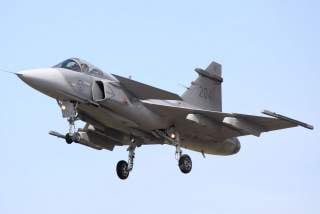Don't Want an F-35 in Your Air Force? This Plane Can Do The Job.
From Sweden.
The E/F variant adds greater range and payload capability while vastly improving the Gripens’ avionics.
While complex high-end jet fighters like the Lockheed Martin F-35 Joint Strike Fighter, Dassault Rafale and Eurofighter Typhoon dominate the headlines when it comes to the global fighter market, not every country needs or even wants a top-of-the-line warplane. While some nations—particularly those that have poor relations with the West—might opt for Russian or Chinese-built machines, there is a sizeable market for lower cost alternatives. It is this market that Sweden’s Saab JAS-39 Gripen dominates.
(This first appeared in 2015.)
The JAS-39 is an excellent low cost fourth-generation fighter. Originally developed in Sweden the 1980s—part of the that nation’s efforts at maintaining a neutral foreign policy stance—the Nordic machine is designed to be relatively cheap, easy to maintain and fight off any potential aggressor.
Those traits have made the Gripen an attractive prospect for many nations including Brazil, South Africa, Czech Republic, Hungary and Thailand. More countries—deterred by the outrageous price tags of rival machines—are likely to jump onboard the Gripen bandwagon as more advanced derivatives of the Swedish jet enter production. Croatia, Finland and Bulgaria are but a few possibilities as they begin to look for replacements for ageing hardware.
Sweden started developing the Gripen in 1979 as a replacement for its J-35 Draken and JA-37 Viggen fighters. The basic requirement was a Mach 2.0-class fighter with good short-field performance. Sweden expected to disperse its aircraft in case of an invasion, which meant that the aircraft had to be able to operate from 2,600ft by 30ft strips. The jets also had be serviceable away from the comforts of a proper airbases since the most likely operating areas were going to be highways.
The aircraft that emerged was a single-engine, single-seat, canard design powered by a Volvo-Flygmotor RM12—a derivative of the F/A-18’s General Electric F404-GE-400. It’s a myth that Sweden developed the Gripen entirely on its own, a lot of the technologies like the engine, were outsourced to keep costs down. (Indeed, the use of British components scuttled a potential deal with Argentina)
Over the years, there have been two previous iterations of the Gripen. The original A and B models gave way to the much-improved C and D model aircraft. Saab is currently developing an advanced next-generation Gripen model called the JAS-39E/F Gripen NG that is likely to be delivered to the Swedish air force in 2018. It will also fly with Brazil’s air force.
The E/F variant adds greater range and payload capability while vastly improving the Gripens’ avionics. Perhaps the most important feature is the new British-built Selex Raven ES-05 active electronically scanned array radar, which replaces the old mechanically-scanned PS-05/A. The Gripen also has comprehensive networking capabilities. The new Gripen’s maximum takeoff weight is increased to more than 36,000lbs up from around 31,000lbs for the C/D variant.
Recommended: What Will the Sixth-Generation Jet Fighter Look Like?
Recommended: Imagine a U.S. Air Force That Never Built the B-52 Bomber
Recommended: Russia's Next Big Military Sale - To Mexico?
Most of the added gross weight comes from a more than forty percent increase in internal fuel capacity. The new jet is also equipped with two additional hardpoints to increase its payload. The aircraft is also slightly longer and has a larger wingspan. As a result of the increased size and weight, the Swedes have adopted the Super Hornet’s F414 engine—but have elected not to license manufacture it as they have done in the past. Performance is spritely—a lightly loaded Gripen NG will hold Mach 1.2 without the afterburner engaged.
With the Gripen NG soon to be delivered to the Swedish and Brazilian air forces, the JAS-39 will be undoubtedly remain a competitor in a multitude of markets around the globe. The Gripen production line is backed up to 2022, but Saab officials have suggested they could sell upgraded versions of the older airframes that are in storage. Saab told reporters at the Paris air show earlier in the year that it might be able to sell between 300 and 450 jets over the next two decades.
Dave Majumdar is the former defense editor of The National Interest.
Image: Creative Commons.

